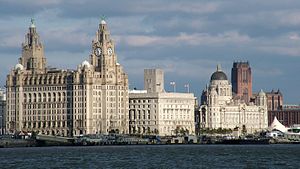Template:Todaysimage2: Difference between revisions
(Still not quite right) |
mNo edit summary |
||
| (One intermediate revision by the same user not shown) | |||
| Line 1: | Line 1: | ||
{{clear}} | |||
'''This week's image''' is: | '''This week's image''' is: | ||
{| class="wikitable" | {| class="wikitable" | ||
|- align="left" | |- align="left" | ||
|[[File:{{FP-{{pickweek}}| | |[[File:{{FP-{{pickweek}}|pic}}|left|thumb|300px|{{FP-{{pickweek}}|cap}}]] | ||
| | | | ||
=={{pickweek}}== | =={{pickweek}}== | ||
{{FP-{{pickweek}}| | {{FP-{{pickweek}}|text}}. ([[{{pickweek}}|Read more]])'' | ||
|} | |} | ||
Latest revision as of 13:33, 1 December 2010
This week's image is:
 |
LiverpoolLiverpool is a major city in southern Lancashire. It stands on the eastern side of the Mersey Estuary. It was founded as a borough by King John in 1207 and was granted city status in 1880. Today it is the fourth largest city in the United Kingdom. The urbanisation and expansion of Liverpool were both largely brought about by the city's status as a major port. By the 18th century, trade from Ireland, the Americas, the West Indies and Europe furthered the economic expansion of Liverpool. By the early 19th century, 40% of the world's trade passed through Liverpool's docks, contributing to Liverpool's rise as a major city. The popularity of The Beatles and the other groups from the "Merseybeat" era contributes to Liverpool's status as a tourist destination; tourism forms a significant part of the city's modern economy.. (Read more) |